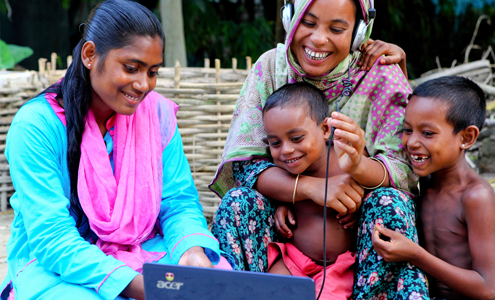
Guinea: Community Dialogues – Bringing Communities and Health Facilities Together
Case study outlining how HC3 used community dialogues to create and facilitate exchanges between community members and health providers to glean perceptions of health services and solicit suggestions for improvement following the Ebola crisis.

Guinea: Bridges of Hope – Getting Communities Engaged in Health Decisions
Case study outlining how HC3 used the Bridges of Hope toolkit in Guinea for community-level engagement to create demand for health services following the Ebola crisis.

Adapting the Demand Generation Implementation Kit: Development of an Android Mobile Application for Adolescents and Youth on Sexual and Reproductive Health in Nepal
Case study outlining the development of an android mobile application for adolescents and youth on sexual and reproductive health in Nepal.

Participatory Communication Strategy
HC3 worked in close collaboration with the USAID mission in Guatemala and 12 USAID-funded health and development partners active in the Western Highlands to develop the "Juntos Prosperamos" ("Together We Prosper") brand and a social and behavior change communication (SBCC) strategy. The strategy unifies activities across the areas important during the “First 1,000 Days” (from the beginning of a pregnancy through the end of a child’s first year) – safe pregnancy, exclusive breastfeeding, complementary feeding, birth spacing, hygiene, sanitation and baby WASH, and home-based agriculture, as well as relevant gender norms.

Estrategia de Comunicación Participativa
Fortaleciendo el Hogar y el Liderazgo para la Reducción de la…

Healthy Life Campaign Materials (Liberia)
While the Healthy Life logo has existed since 2010, HC3 supported…

Journey to a Bright Future Guide
This facilitator manual is part of a set of materials developed for use under the HC3/Sierra Leone project that will be used for training and leading community discussions which complement the HC3/Sierra Leone activities being carried out at the health facility level, as well as through mass media and national level capacity strengthening.

Webinar: Six Local Stories of Generating Demand for RMNCAH Commodities
This September 8, 2016 webinar brought together six panelists – all recipients of a small project grant – to discuss their experiences in adapting and using the Demand Generation I-Kit for their local context and their efforts toward developing and implementing demand generation strategies in their respective countries.

The Role of Health Systems and Policy in Producing Behavior and Social Change to Enhance Child Survival and Development in Low- and Middle-Income Countries: An Examination of the Evidence
This review provides conclusions and recommendations on the studies of evidence-based behavior change interventions that addressed health systems or policy. The author's recommendations are offered around each topic area (pneumonia/diarrhea, neonatal survival, nutrition, PMTCT, malaria, healthy pregnancies, and immunizations) that is classified by the World Health Organization Health System Building Blocks of health system delivery, health workforce and health financing, leadership and governance.

Community Engagement to Enhance Child Survival and Early Development in Low- and Middle-Income Countries: An Evidence Review
An evidence review team was organized to address the question, ‘‘What are the effective means to facilitate and empower communities to organize and advocate for interventions to achieve behavioral and social changes that are needed to accelerate reductions in under-5 mortality and optimize healthy and protective child development to age 5?’’ This article is a report from the evidence review team.

The Demand Generation Implementation Kit
The Demand Generation Implementation Kit (I-Kit) is a step-by-step guide to developing communication strategies to increase demand for nine priority commodities, and provides cross-cutting tools, guidance and adaptable commodity-specific content.
